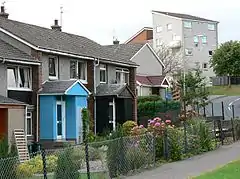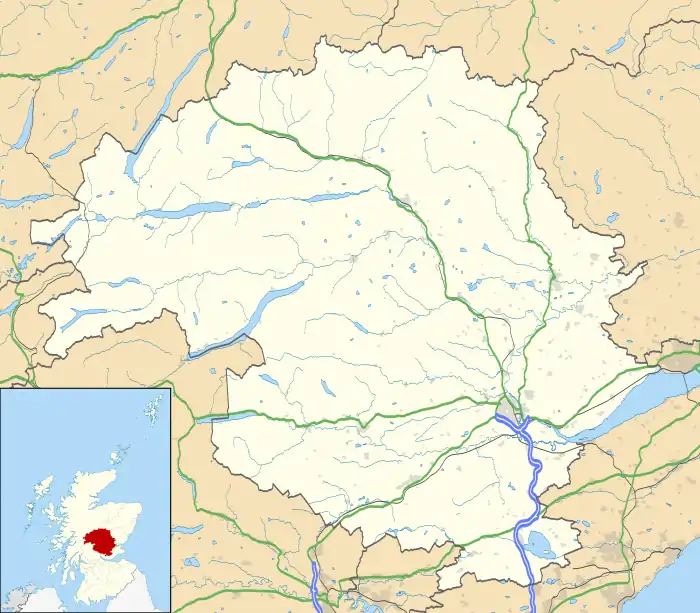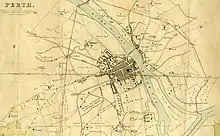Tulloch, Perth and Kinross
Tulloch, formerly known as Bleachfield,[1] is a residential area of Perth, Scotland, approximately 1.5 miles (2.4 km) north-west of the centre of Perth. Tulloch is the western part of the area that borders Hillyland.[2]
| Tulloch | |
|---|---|
 A row of terraced housing on Tulloch's Primrose Place | |
 Tulloch Location within Perth and Kinross | |
| OS grid reference | NO095255 |
| Council area | |
| Lieutenancy area | |
| Country | Scotland |
| Sovereign state | United Kingdom |
| Post town | PERTH |
| Postcode district | PH1 |
| Dialling code | 01738 |
| Police | Scotland |
| Fire | Scottish |
| Ambulance | Scottish |
| UK Parliament | |
| Scottish Parliament | |
The main access road to Tulloch, from the east or west, is Tulloch Road, reached via the Crieff Road (A85), which bounds it to the south. It is also accessible, albeit less directly, from the Dunkeld Road (A912), which bounds it to the north-east, via a modern housing development. It is bounded to the north-west by the A9.
Tulloch has a small shopping precinct, Tulloch Square, located just off Tulloch Terrace. Tulloch Primary School, founded in 1969, is located on Gillespie Place.[3] It can accommodate 400 pupils.[4]
Primrose Crescent, a main thoroughfare which, upon merging from Tulloch Road and Hillyland, circumnavigates Tulloch's oldest residential area before joining up with Tulloch Road again just before its western junction with Crieff Road.

The skyline is dominated by several high-rise flats (one of which is in view in the background of the infobox image).
In addition to the new housing development in the north-east of Tulloch/Hillyland, homes have also been built to the north and west. These are in addition to the first development (Sandeman Court) that went up in the 1980s in the valley behind the primary school, near the railway siding at the bottom of the hill. Between the housing and the railway siding is Perth Lade, which is sourced from Low's Work, a weir on the River Almond south of Almondbank, and empties 4.5 miles (7.2 km) away into the River Tay, near Smeaton's Bridge, via the city.[5][6] A walking path runs parallel to the lade. Ladeside Court, a cul-de-sac off Fairfield Avenue, takes its name from the body of water.
J. Pullar and Sons Ltd.'s Tulloch Works, a dry cleaning plant, once stood on the site of the present-day Bracken Brae.[7] At the turn of the 20th century, architectural firm comprising John Honeyman, John Keppie and Charles Rennie Mackintosh designed a row of buildings for workers at the dyeworks. They were single-storey, semi-detached roughcast cottages. There were also two two-storey blocks containing a total of ten flats. The eight cottages remain, today's 61–75 Tulloch Terrace;[8] the two flats have been demolished.[9] Pullars also built Tulloch School, for their workers' children, in 1895.[10] The school closed in 1911,[11] and the building was later used by the Tulloch Institute.[10]
From certain parts of Tulloch, views are afforded of the hills beyond Scone to the east, including an obelisk on the 279-foot (85 m) summit of a hill near Muirend. To the north, the Grampian Mountains can be seen.
Sport
McDiarmid Park, the home of Perth's professional football club, St Johnstone, is located on Crieff Road at the western edge of Tulloch, in close proximity to the crematorium, while junior club Kinnoull are based on Tulloch Road.[12]
Transport
Tulloch can be reached via the number 1 and number 2 buses from the centre of Perth. The number 1 originates from Mill Street;[13] the number 2 from South Street.[14]
Businesses
Morris Young Ltd., a haulage company, was located between Crieff and Tulloch Roads just beyond their junction between 1952 and 2020. Its lorry fleet was visible parked atop the hill located at the former Hillyland Farm.
Notable people
- Stuart Cosgrove – prior to moving to nearby Letham, Cosgrove and his family lived in Tulloch[15]
- Archibald Sandeman, scholar[16]
Gallery
References
- The Courier, 27 June 1893, p. 5
- "Over £1million boost for home improvements in Hillyland" Archived 7 July 2013 at archive.today - Perth & Kinrosshire Council, 24 May 2013
- "Tulloch Primary School at AXCIS.co.uk". Archived from the original on 5 August 2007. Retrieved 22 February 2008.
- "PICTURES: £11m new primary school opened in Perth" - The Courier, 26 June 2018
- A Perth Lade - Alder Archaeology
- "Take a Hike: The Lade, Perth, Perth & Kinross" - The Courier, 20 April 2019
- Britain from Above
- 61–75 Tulloch Terrace – Google Street View, May 2009
- M200 Workmen's housing, Tulloch, Perth – Mackintosh Architecture
- Buchan, Jamie. "New campaign to revamp historic Tulloch landmark". The Courier. Retrieved 21 April 2023.
- Photographic Collection, Perth Museum, Ref: 1981.820.82
- "Perthshire junior football review, 26 January 2010" - Perthshire Advertiser, 26 January 2010
- Stagecoach - Timetables Archived 10 August 2013 at the Wayback Machine
- Stagecoach - Timetables Archived 10 August 2013 at the Wayback Machine
- "BROADCASTER STUART COSGROVE IS FULL OF NORTHERN SOUL" - ScottishField.co.uk, 21 June 2019
- Library World, Volume 1 (1899), p. 94
External links
- A view of Tulloch, looking west. Tulloch Primary School can be seen at the bottom. McDiarmid Park is just left of centre. To its left, the Crieff Road is seen extending into the distance.
- A photograph of a bus on Murray Street in Perth heading for Tulloch, via Letham
- Tulloch Primary School


